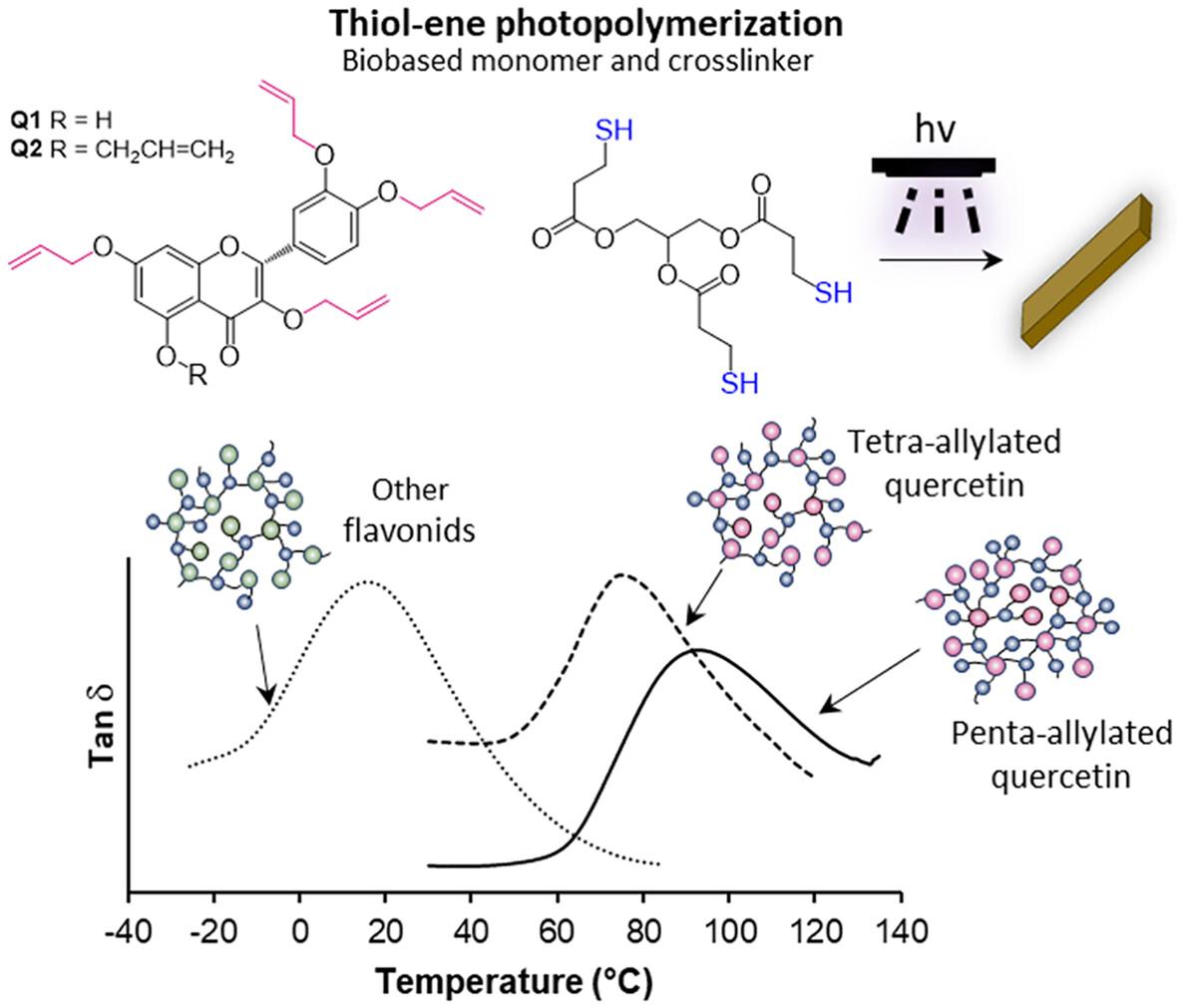Víctor D Lechuga Islas, Ricardo Acosta Ortiz, Roberto Yañez Macías, Alan I Hernández Jiménez
求助PDF
{"title":"利用槲皮素烯丙基化和硫醇烯点击光聚合技术生产具有强热力学性能的生物基聚合物热固性塑料","authors":"Víctor D Lechuga Islas, Ricardo Acosta Ortiz, Roberto Yañez Macías, Alan I Hernández Jiménez","doi":"10.1002/pi.6670","DOIUrl":null,"url":null,"abstract":"<p>The development of biobased and functionalized monomers along with eco-friendly photopolymerization processes represent promising methods for the development of renewable and more environmentally friendly thermosets. Thiol–ene ‘click’ photopolymerization is particularly advantageous in this regard; however, the materials derived from this method often exhibit low glass transition temperatures (<i>T</i><sub>g</sub>) and unsuitable thermomechanical properties for applications at room temperature. Herein, we report the synthesis of biobased allyl derivatives from quercetin, a renewable flavonoid compound widely available in fruits, vegetables and plants. We demonstrated the isolation of tetra- and penta-allylated quercetin (<b>Q1</b> and <b>Q2</b>, respectively) and their subsequent photoactivated thiol–ene polymerization. By introducing a biobased thiol curing agent (PTTMP) derived from glycerol and mercaptopropionic acid, we produced fully biobased crosslinked thermosets with high content of aromatic moieties provided by the framework of the monomers. Real-time infrared spectroscopy showed the effective thiol–ene photopolymerization of <b>Q1</b> and <b>Q2</b> and PTTMP with conversions of 60% and 75%, respectively, after 15 min of UV irradiation. Due to the modulated crosslinking degree from the allyl group functionalization in the monomers, the biobased crosslinked networks showed storage moduli from 420 to 739 MPa, thermal stability from 220 to 257 °C and <i>T</i><sub>g</sub> values ranging from 75 to 90 °C. This work outlines straightforward strategies for creating biobased thermosets that overcome the limited thermomechanical properties of thiol–ene networks and offer potential antimicrobial and antioxidant properties. © 2024 Society of Chemical Industry.</p>","PeriodicalId":20404,"journal":{"name":"Polymer International","volume":"73 10","pages":"864-873"},"PeriodicalIF":3.6000,"publicationDate":"2024-06-18","publicationTypes":"Journal Article","fieldsOfStudy":null,"isOpenAccess":false,"openAccessPdf":"","citationCount":"0","resultStr":"{\"title\":\"Quercetin allylation and thiol–ene click photopolymerization to produce biobased polymer thermosets with robust thermomechanical properties\",\"authors\":\"Víctor D Lechuga Islas, Ricardo Acosta Ortiz, Roberto Yañez Macías, Alan I Hernández Jiménez\",\"doi\":\"10.1002/pi.6670\",\"DOIUrl\":null,\"url\":null,\"abstract\":\"<p>The development of biobased and functionalized monomers along with eco-friendly photopolymerization processes represent promising methods for the development of renewable and more environmentally friendly thermosets. Thiol–ene ‘click’ photopolymerization is particularly advantageous in this regard; however, the materials derived from this method often exhibit low glass transition temperatures (<i>T</i><sub>g</sub>) and unsuitable thermomechanical properties for applications at room temperature. Herein, we report the synthesis of biobased allyl derivatives from quercetin, a renewable flavonoid compound widely available in fruits, vegetables and plants. We demonstrated the isolation of tetra- and penta-allylated quercetin (<b>Q1</b> and <b>Q2</b>, respectively) and their subsequent photoactivated thiol–ene polymerization. By introducing a biobased thiol curing agent (PTTMP) derived from glycerol and mercaptopropionic acid, we produced fully biobased crosslinked thermosets with high content of aromatic moieties provided by the framework of the monomers. Real-time infrared spectroscopy showed the effective thiol–ene photopolymerization of <b>Q1</b> and <b>Q2</b> and PTTMP with conversions of 60% and 75%, respectively, after 15 min of UV irradiation. Due to the modulated crosslinking degree from the allyl group functionalization in the monomers, the biobased crosslinked networks showed storage moduli from 420 to 739 MPa, thermal stability from 220 to 257 °C and <i>T</i><sub>g</sub> values ranging from 75 to 90 °C. This work outlines straightforward strategies for creating biobased thermosets that overcome the limited thermomechanical properties of thiol–ene networks and offer potential antimicrobial and antioxidant properties. © 2024 Society of Chemical Industry.</p>\",\"PeriodicalId\":20404,\"journal\":{\"name\":\"Polymer International\",\"volume\":\"73 10\",\"pages\":\"864-873\"},\"PeriodicalIF\":3.6000,\"publicationDate\":\"2024-06-18\",\"publicationTypes\":\"Journal Article\",\"fieldsOfStudy\":null,\"isOpenAccess\":false,\"openAccessPdf\":\"\",\"citationCount\":\"0\",\"resultStr\":null,\"platform\":\"Semanticscholar\",\"paperid\":null,\"PeriodicalName\":\"Polymer International\",\"FirstCategoryId\":\"92\",\"ListUrlMain\":\"https://onlinelibrary.wiley.com/doi/10.1002/pi.6670\",\"RegionNum\":4,\"RegionCategory\":\"化学\",\"ArticlePicture\":[],\"TitleCN\":null,\"AbstractTextCN\":null,\"PMCID\":null,\"EPubDate\":\"\",\"PubModel\":\"\",\"JCR\":\"Q2\",\"JCRName\":\"POLYMER SCIENCE\",\"Score\":null,\"Total\":0}","platform":"Semanticscholar","paperid":null,"PeriodicalName":"Polymer International","FirstCategoryId":"92","ListUrlMain":"https://onlinelibrary.wiley.com/doi/10.1002/pi.6670","RegionNum":4,"RegionCategory":"化学","ArticlePicture":[],"TitleCN":null,"AbstractTextCN":null,"PMCID":null,"EPubDate":"","PubModel":"","JCR":"Q2","JCRName":"POLYMER SCIENCE","Score":null,"Total":0}
引用次数: 0
引用
批量引用


 求助内容:
求助内容: 应助结果提醒方式:
应助结果提醒方式:


